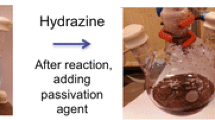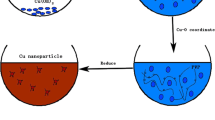Abstract
Size-controllable copper nanomaterials were easily obtained via an improved polyol process by regulating the dosage of copper source and reducing agent. The monodisperse copper nanoparticles with strong antioxidation properties were employed as fillers to fabricate conductive ink. The copper-based ink could be screen-printed onto flexible substrates, which shows persistent stability and uniform properties without color change for a few days. After heating at 240 °C (40 min) in N2 atmosphere, a low electrical resistivity of 16.2 μΩ cm was obtained for the copper nanomaterial-based conductive pattern.







Similar content being viewed by others
References
Tam SK, Fung KY, Ng KM (2016) Copper pastes using bimodal particles for flexible printed electronics. J Mater Sci 51:1914–1922. https://doi.org/10.1007/s10853-015-9498-7
Li JJ, Cheng CL, Shi TL, Fan JH, Yu X, Cheng SY, Liao GL, Tang ZR (2016) Surface effect induced Cu–Cu bonding by Cu nanosolder paste. Mater Lett 184:193–196
Kim D, Jeong S, Moon J (2006) Synthesis of silver nanoparticles using the polyol process and the influence of precursor injection. Nanotechnology 17:4019–4024
Perelaer J, Smith PJ, Mager D, Soltman D, Volkman SK, Subramanian V, Korvink JG, Schubert US (2010) Printed electronics: the challenges involved in printing devices, interconnects, and contacts based on inorganic materials. J Mater Chem 20:8446–8453
Guo R, Yu Y, Xie Z, Liu X, Zhou X, Gao Y, Liu Z, Zhou F, Yang Y, Zheng Z (2013) Matrix-assisted catalytic printing for the fabrication of multiscale, flexible, foldable, and stretchable metal conductors. Adv Mater 25:3343–3350
Jiu J, Zhang H, Nagao S, Sugahara T, Kagami N, Suzuki Y, Akai Y, Suganuma K (2016) Die-attaching silver paste based on a novel solvent for high-power semiconductor devices. J Mater Sci 51:3422–3430. https://doi.org/10.1007/s10853-015-9659-8
Komoda N, Nogi M, Suganuma K, Otsuka K (2012) Highly sensitive antenna using inkjet overprinting with particle-free conductive inks. ACS Appl Mater Interfaces 4:5732–5736
Dong Q, Huang C, Duan G, Zhang F, Yang D (2017) Facile synthesis and electrical performance of silica-coated copper powder for copper electronic pastes on low temperature co-fired ceramic. Mater Lett 186:263–266
Deng D, Jin Y, Cheng Y, Qi T, Xiao F (2013) Copper nanoparticles: aqueous phase synthesis and conductive films fabrication at low sintering temperature. ACS Appl Mater Interfaces 5:3839–3846
Perelaer J, Gans BJ, Schubert US (2006) Ink-jet printing and microwave sintering of conductive silver tracks. Adv Mater 18:2101–2104
Yan GQ, Wang L, Zhang L (2010) Recent research progress on preparation of silver nanowires by soft solution method, preparation of gold nanotubes and Pt nanotubes from resultant silver nanowires and their applications in conductive adhesive. Rev Adv Mater Sci 24:10–25
Ghosh S, Yang R, Kaumeyer M, Zorman C, Rowan S, Feng P, Sankaran R (2014) Fabrication of electrically conductive metal patterns at the surface of polymer films by microplasma-based direct writing. ACS Appl Mater Interfaces 6:3099–3104
Jang S, Seo Y, Choi J, Kim T, Cho J, Kim S, Kim D (2010) Sintering of inkjet printed copper nanoparticles for flexible electronics. Scripta Mater 62:258–261
Eivazihollagh A, Bäckström J, Dahlström C, Carlsson F (2017) One-pot synthesis of cellulose-templated copper nanoparticles with antibacterial properties. Mater Lett 187:170–172
Zhang HX, Siegert U, Liu R, Cai WB (2009) Facile fabrication of ultrafine copper nanoparticles in organic solvent. Nanoscale Res Lett 4:705–708
Sarkar A, Mukherjee T, Kapoor S (2008) PVP-stabilized copper nanoparticles: a reusable catalyst for “click” reaction between terminal alkynes and azides in nonaqueous solvents. J Phys Chem C 112:3334–3340
Park BK, Jeong S, Kim D, Moon J, Lim S, Kim JS (2007) Synthesis and size control of monodisperse copper nanoparticles by polyol method. J Colloid Interface Sci 311:417–424
Xu M, Peng W, Cai J, Li X, Liu Z, Huai X (2015) Ultrasound-assisted synthesis and characterization of ultrathin copper nanowhiskers. Mater Lett 161:164–167
Yan J, Zou G, Hu A, Zhou YN (2011) Preparation of PVP coated Cu NPs and the application for low-temperature bonding. J Mater Chem 21:15981–15986
Magdassi S, Grouchko M, Kamyshny A (2010) Copper nanoparticles for printed electronics: routes towards achieving oxidation stability. Materials 3:4626–4638
Sun JH, Jing Y, Jia YZ, Tillard M, Belin C (2005) Mechanism of preparing ultrafine copper powder by polyol process. Mater Lett 59:3933–3936
Mott D, Galkowski J, Wang LY, Luo J, Zhong CJ (2007) Synthesis of size-controlled and shaped copper nanoparticles. Langmuir 23:5740–5745
Engels V, Benaskar F, Jefferson DA, Johnson BF, Wheatley AE (2010) Nanoparticulate copper-routes towards oxidative stability. Dalton Trans 28:6496–6502
Acknowledgements
This work is partially supported by the National Natural Science Foundation of China (61704033, U1601202), the Foundation for Distinguished Young Talents in Higher Education of Guangdong (2016KQNCX046), and the Fund of Guangdong R&D Science and Technology (2017A050501053, 2017A010106005, 2017A050506053).
Author information
Authors and Affiliations
Corresponding author
Ethics declarations
Conflict of interest
The authors declare no competing financial interest.
Rights and permissions
About this article
Cite this article
Zhang, Y., Cui, C., Yang, B. et al. Size-controllable copper nanomaterials for flexible printed electronics. J Mater Sci 53, 12988–12995 (2018). https://doi.org/10.1007/s10853-018-2564-1
Received:
Accepted:
Published:
Issue Date:
DOI: https://doi.org/10.1007/s10853-018-2564-1




